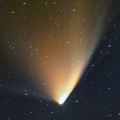
|
It passed the perihelion on Mar. 10, and brightened up to 0-1 mag. Now it is fading. But it is still bright as 8.0 mag (May 18, Uwe Pilz). It is observable all night in the Northern Hemisphere. It is not observable in the Southern Hemisphere for a while after this. The Earth will pass through the comet's orbital plane on May 27, then the dust tail will look dense and straight.
Date(TT) R.A. (2000) Decl. Delta r Elong. m1 Best Time(A, h)
June 1 17 20.44 84 31.4 1.849 1.836 73 8.3 0:49 (180, 40)
June 8 15 30.63 80 54.9 1.937 1.950 75 8.6 22:17 (180, 44)
|
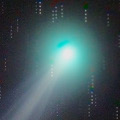
|
It approached to the sun down to 0.73 A.U. on Mar. 24, and brightened up to 4.7 mag (Mar. 11, Michael Mattiazzo). Now it is fading. But it is still bright as 6.8 mag (May 19, Uwe Pilz). In the Northern Hemisphere, it will be getting higher gradually, then it keeps observable in good condition while fading gradually. In the Southern Hemisphere, it keeps locating low in the morning sky after this.
Date(TT) R.A. (2000) Decl. Delta r Elong. m1 Best Time(A, h)
June 1 0 20.64 33 24.2 1.746 1.461 56 8.7 3:03 (250, 33)
June 8 0 19.01 38 47.6 1.758 1.560 61 9.2 3:00 (246, 40)
|

|
It brightens up to 10 mag in summer. But the condition is worst and the comet will be hardly observable in this apparition. In the Northern Hemisphere, it will be observable in autumn when the comet will be fainter than 16 mag.
Date(TT) R.A. (2000) Decl. Delta r Elong. m1 Best Time(A, h)
June 1 3 25.94 13 54.0 2.089 1.172 18 12.2 3:03 (243,-12)
June 8 3 53.65 16 8.5 2.056 1.134 17 11.7 3:00 (241,-11)
|
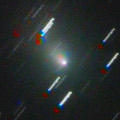
|
Now it is so bright as 10.5 mag (May 19, Chris Wyatt). In the Southern Hemisphere, it keeps observable for a long time until the comet fades out, although it keeps locating low. It will never be observable again in the Northern Hemisphere.
Date(TT) R.A. (2000) Decl. Delta r Elong. m1 Best Time(A, h)
June 1 6 0.70 -1 49.4 2.310 1.541 31 12.2 20:52 (102,-20)
June 8 6 15.52 -4 38.7 2.322 1.564 32 12.3 20:57 (102,-25)
|

|
It brightened up to 12 mag in 2012. It is bright as 14.1 mag still now (May 19, Chris Wyatt). It keeps 13-14 mag until autumn. It locates somewhat low in the Northern Hemisphere.
Date(TT) R.A. (2000) Decl. Delta r Elong. m1 Best Time(A, h)
June 1 20 0.11 -29 31.0 2.162 2.955 133 12.9 3:03 (355, 25)
June 8 19 59.01 -30 22.1 2.109 2.963 140 12.9 2:54 ( 0, 25)
|

|
It brightened up to 11-12 mag in 2012. Now it is bright as 10.8 mag (May 10, Juan Jose Gonzalez). It keeps observable in good condition until July in the Northern Hemisphere, or until September in the Southern Hemisphere.
Date(TT) R.A. (2000) Decl. Delta r Elong. m1 Best Time(A, h)
June 1 13 39.85 -11 41.9 5.204 5.985 136 13.0 20:59 ( 0, 43)
June 8 13 33.84 -11 16.8 5.325 6.011 128 13.0 20:57 ( 11, 43)
|
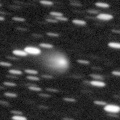
|
Now it is 13.0 mag (May 17, Chris Wyatt). It keeps bright at 13-14 mag for a long time until 2014. It keeps observable for a long time in the Northern Hemisphere. It locates somewhat low in the Southern Hemisphere.
Date(TT) R.A. (2000) Decl. Delta r Elong. m1 Best Time(A, h)
June 1 21 5.65 33 5.0 5.720 5.900 95 13.4 3:03 (270, 72)
June 8 21 0.78 33 13.7 5.630 5.901 100 13.3 3:00 (275, 78)
|
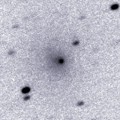
|
Now it is faint as 14.3 mag (May 5, Toshiyuki Takahashi).
Date(TT) R.A. (2000) Decl. Delta r Elong. m1 Best Time(A, h)
June 1 13 37.86 -21 41.7 5.414 6.214 138 13.6 20:57 ( 0, 33)
June 8 13 36.41 -21 24.7 5.487 6.213 132 13.6 20:57 ( 8, 33)
|
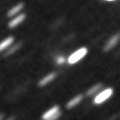
|
It brightened up to 14.4 mag until April (Apr. 13, Sandor Szabo). It will brighten up to 12 mag from summer to autumn. Now it is not observable. In the Southern Hemisphere, it will become observable in August, then it keeps observable while fading gradually. It will never be observable again in the Northern Hemisphere.
Date(TT) R.A. (2000) Decl. Delta r Elong. m1 Best Time(A, h)
June 1 4 46.32 31 15.8 2.797 1.805 9 13.8 20:52 (139, -9)
June 8 5 3.08 29 22.7 2.755 1.750 6 13.6 3:00 (220,-13)
|
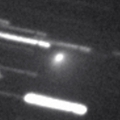
|
Now it is bright as 13.1 mag (May 17, Chris Wyatt). It keeps locating in the morning sky for a long time after this. I will keep the current brightness for a long time.
Date(TT) R.A. (2000) Decl. Delta r Elong. m1 Best Time(A, h)
June 1 0 14.00 10 48.5 2.059 1.841 63 13.7 3:03 (273, 24)
June 8 0 26.31 11 18.7 2.056 1.903 66 13.9 3:00 (275, 27)
|
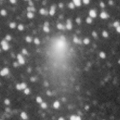
|
Now it is bright as 12.9 mag (May 12, Carlos Labordena). It keeps observable at 11-13 mag for a long time from 2012 summer to 2013 summer.
Date(TT) R.A. (2000) Decl. Delta r Elong. m1 Best Time(A, h)
June 1 13 35.68 18 23.8 2.659 3.289 120 13.8 20:55 ( 0, 73)
June 8 13 29.18 19 19.8 2.821 3.346 112 14.0 20:57 ( 30, 72)
|
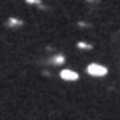
|
Now it is 15.5 mag (May 15, M.-T. Hui, X. Gao). It is expected to be a great comet in 2013 autumn when the comet approaches to the sun down to only 0.01 A.U. It keeps visible with naked eyes from November to January, and can be extremely bright as Venus or more at the highlight. It became unobservable in late May. The condition is excellent in the Northern Hemisphere. It will appear in the morning sky again in late August, then it keeps observable almost all through the period of brightening, at the highlight, and of fading. The condition is not good in the Southern Hemisphere. It is not observable at all the latter part of the highlight, and it keeps low all through the period.
Date(TT) R.A. (2000) Decl. Delta r Elong. m1 Best Time(A, h)
June 1 6 59.29 28 14.3 4.312 3.505 33 14.1 20:52 (118, 10)
June 8 7 4.72 27 56.4 4.281 3.414 27 14.0 20:57 (121, 5)
|
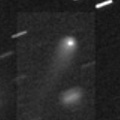
|
Now it is 14.1 mag (May 10, Juan Jose Gonzalez). It keeps 13 mag and observable in good condition in the Northern Hemisphere for a long time from 2013 to 2014. In the Southern Hemisphere, it is not observable until 2014 autumn.
Date(TT) R.A. (2000) Decl. Delta r Elong. m1 Best Time(A, h)
June 1 8 59.13 50 14.7 4.375 3.933 57 14.2 20:52 (130, 39)
June 8 9 0.09 50 13.8 4.429 3.903 52 14.1 20:57 (131, 34)
|
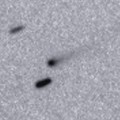
|
Now it is 14.4 mag (Apr. 30, Taras Prystavski). It keeps bright as 13-14 mag for a long time from 2013 to 2014.
Date(TT) R.A. (2000) Decl. Delta r Elong. m1 Best Time(A, h)
June 1 14 9.91 -9 54.0 2.508 3.374 143 14.5 21:29 ( 0, 45)
June 8 14 7.29 -9 59.2 2.557 3.361 135 14.5 20:59 ( 0, 45)
|

|
Big asteroid discovered in 1906. It suddenly showed the cometary activity on Dec. 11, 2010, probably due to an impact of a small object. It has already turned to be stellar. It locates high in the Southern Hemisphere. But it still locates very low in the Northern Hemisphere.
Date(TT) R.A. (2000) Decl. Delta r Elong. m1 Best Time(A, h)
June 1 0 21.91 -12 45.5 3.037 2.876 71 14.6 3:03 (292, 8)
June 8 0 29.59 -12 22.7 2.963 2.888 75 14.6 3:00 (294, 12)
|
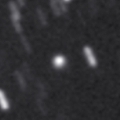
|
Now it is 14.4 mag (May 2, Yasukazu Ikari). It is expected to brighten up to 5-6 mag in 2014 autumn. In 2013, it keeps observable in good condition until autumn when it brigthens up to 13-14 mag.
Date(TT) R.A. (2000) Decl. Delta r Elong. m1 Best Time(A, h)
June 1 16 46.00 21 6.5 4.840 5.622 136 14.9 0:09 ( 0, 76)
June 8 16 38.48 21 27.0 4.790 5.557 135 14.8 23:29 ( 0, 76)
|
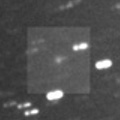
|
Now it is 14.2 mag (May 2, Yasukazu Ikari). It reaches up to 14-15 mag from spring to summer. It is observable in excellent condition in the Southern Hemisphere. It locates low in the Northern Hemisphere.
Date(TT) R.A. (2000) Decl. Delta r Elong. m1 Best Time(A, h)
June 1 13 18.56 -27 0.3 2.558 3.355 135 14.9 20:52 ( 4, 28)
June 8 13 9.20 -23 54.0 2.653 3.357 126 15.0 20:57 ( 15, 30)
|
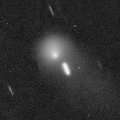
|
Now it is 14.1 mag (Mar. 5, Hidetaka Sato). It will be fading slowly after this. But it keeps 15 mag in 2013. It becomes temporarily low in May, but will be observable in good condition again after June in the Southern Hemisphere. It is not observable now in the Northern Hemisphere.
Date(TT) R.A. (2000) Decl. Delta r Elong. m1 Best Time(A, h)
June 1 3 46.48 -24 59.1 7.244 6.616 48 15.1 3:03 (276,-39)
June 8 3 50.16 -24 33.6 7.240 6.644 50 15.1 3:00 (278,-35)
|
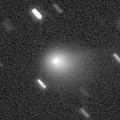
|
It brightened up to 9.0 mag in 2012 autumn (Nov. 4, Juan Jose Gonzalez). However, it faded out unexpectedly around the perihelion passage. Now it is fainter than originally predicted by 4-5 mag. Now it is 14.3 mag (May 10, Taras Prystavski). In the Southern Hemisphere, it keeps observable in good condition while fading slowly after this. In the Northern Hemisphere, it will not be observable after this.
Date(TT) R.A. (2000) Decl. Delta r Elong. m1 Best Time(A, h)
June 1 2 11.98 -42 20.1 2.658 2.542 72 15.1 3:03 (304,-28)
June 8 2 27.99 -42 21.1 2.680 2.599 74 15.2 3:00 (305,-26)
|
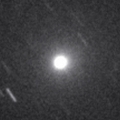
|
Emmanuel Jehin detected the small outburst on May 15. Now it is bright and visible visually at 12.6 mag (May 17, Chris Wyatt).
Date(TT) R.A. (2000) Decl. Delta r Elong. m1 Best Time(A, h)
June 1 10 36.43 3 41.8 1.762 2.015 88 15.4 20:52 ( 62, 39)
June 8 10 46.82 1 38.8 1.847 2.034 85 15.6 20:57 ( 65, 33)
|
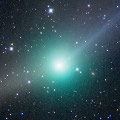
|
It kept as bright as 6-7 mag for a long time from 2011 summer to 2012 spring. Now it is fading. But it is bright as 15.9 mag still now (Apr. 13, Ken-ichi Kadota). Now it is not observable in the Northern Hemisphere. In July, it will be too low to observe also in the Southern Hemipshere.
Date(TT) R.A. (2000) Decl. Delta r Elong. m1 Best Time(A, h)
June 1 8 14.28 -7 7.0 6.423 5.996 60 15.4 20:52 ( 78, 4)
June 8 8 16.52 -7 11.3 6.569 6.056 55 15.5 20:57 ( 82, -2)
|
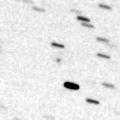
|
It brightened very rapidly. Now it is so bright as 14.7 mag (May 28, Hidetaka Sato). It keeps observable in good condition for a while in the Southern Hemipshere. It will be unobservable in late June in the Northern Hemisphere.
Date(TT) R.A. (2000) Decl. Delta r Elong. m1 Best Time(A, h)
June 1 12 34.91 -18 35.1 1.412 2.149 123 15.5 20:52 ( 17, 35)
June 8 12 10.70 -18 37.0 1.527 2.125 111 15.5 20:57 ( 32, 30)
|
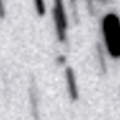
|
Now it is 16.7 mag (May 23, A. Diepvens). It is expected to brighten up to 14 mag in July and August. In the Southern Hemisphere, it keeps observable for a long time until the comet fades out. It keeps observable in good condition until September also in the Northern Hemisphere.
Date(TT) R.A. (2000) Decl. Delta r Elong. m1 Best Time(A, h)
June 1 22 2.99 20 40.7 2.322 2.525 89 15.9 3:03 (285, 56)
June 8 21 58.60 19 39.7 2.165 2.495 96 15.6 3:00 (294, 61)
|
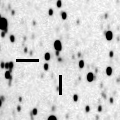
|
Now it is 17.2 mag (Apr. 11, Hidetaka Sato). It keeps 16 mag and observable in good condition until July.
Date(TT) R.A. (2000) Decl. Delta r Elong. m1 Best Time(A, h)
June 1 18 43.16 12 12.9 1.432 2.254 133 15.8 2:06 ( 0, 67)
June 8 18 26.96 17 31.8 1.424 2.258 134 15.8 1:23 ( 0, 72)
|
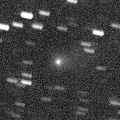
|
It brightened up to 15.5 mag in 2012 summer. Although it has already passed the perihelion, it tends to become brightest after the perihelion passage. It will be observabel at 16 mag again in 2013 summer. Now it is 18.1 mag, fainter than this ephemeris (Apr. 11, Hidetaka Sato).
Date(TT) R.A. (2000) Decl. Delta r Elong. m1 Best Time(A, h)
June 1 22 31.15 -17 25.5 3.271 3.548 97 16.2 3:03 (315, 24)
June 8 22 34.52 -17 30.6 3.190 3.564 103 16.2 3:00 (320, 27)
|
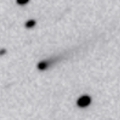
|
Now it is bright as 15.6 mag (Apr. 29, Taras Prystavski). It will be observable at 15-16 mag for a long time from 2013 to 2014.
Date(TT) R.A. (2000) Decl. Delta r Elong. m1 Best Time(A, h)
June 1 11 49.83 5 8.7 3.445 3.837 105 16.2 20:52 ( 44, 52)
June 8 11 52.06 4 38.3 3.540 3.834 99 16.3 20:57 ( 53, 47)
|
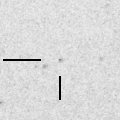
|
Now it is 17.5 mag (Mar. 16, Hidetaka Sato). It keeps observable in good condition at 17 mag from spring to summer.
Date(TT) R.A. (2000) Decl. Delta r Elong. m1 Best Time(A, h)
June 1 18 51.33 -7 39.3 2.039 2.923 144 16.4 2:14 ( 0, 47)
June 8 18 48.83 -6 57.4 2.005 2.930 150 16.3 1:44 ( 0, 48)
|
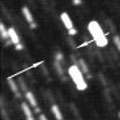
|
Now it is 16.1 mag (Mar. 4, Hidetaka Sato). In the Southern Hemisphere, it will be observable at 15-16 mag in good condition for a long time until summer. It is not observable at all in the Northern Hemisphere.
Date(TT) R.A. (2000) Decl. Delta r Elong. m1 Best Time(A, h)
June 1 4 27.17 -43 42.2 4.924 4.601 65 16.6 3:03 (298,-52)
June 8 4 36.23 -42 59.9 4.949 4.633 66 16.6 3:00 (298,-49)
|
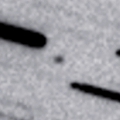
|
It is expected to brighten rapidly and to be observable at 15 mag in good condition from July to August. But actually, it is not detected, fainter than 20 mag (May 19, Hidetaka Sato). It can have been already disintegrated.
Date(TT) R.A. (2000) Decl. Delta r Elong. m1 Best Time(A, h)
June 1 0 4.38 21 29.2 2.450 2.174 62 16.8 3:03 (264, 31)
June 8 23 58.57 21 59.4 2.282 2.153 69 16.6 3:00 (268, 38)
|
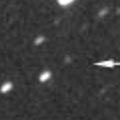
|
Now it is 17.2 mag (May 15, W. Hasubick). It is expected to be observable at 16 mag in good condition in summer and autumn.
Date(TT) R.A. (2000) Decl. Delta r Elong. m1 Best Time(A, h)
June 1 23 12.04 14 30.9 2.127 2.129 76 16.8 3:03 (280, 39)
June 8 23 23.13 15 51.6 2.062 2.129 79 16.8 3:00 (280, 42)
|
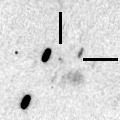
|
It will approach to the Sun down to 0.9 A.U., and to the Earth down to 0.4 A.U. in September. Then it is expected to brighten up to 11-12 mag. Now it is 17.2 mag (May 29, Taras Prystavski). It looks diffuse. In the Northern Hemisphere, it keeps observable in good condition until mid September while brightening rapidly. In the Southern Hemisphre, it keeps locating low for a while. However, it will getting higher after August, and it keeps observable in good condition after that, until the comet fades out.
Date(TT) R.A. (2000) Decl. Delta r Elong. m1 Best Time(A, h)
June 1 13 44.85 52 44.3 1.363 1.790 96 17.2 21:04 (180, 72)
June 8 13 37.82 52 24.3 1.324 1.702 92 16.9 20:57 (166, 72)
|

|
It was predicted to be 17 mag in late May. But actually, it was much fainter, 19-20 mag (May 26, Damian Peach). It was expected to be bright as 16 mag and observable in good condition from summer to autumn. But it can be 18-19 mag at best.
Date(TT) R.A. (2000) Decl. Delta r Elong. m1 Best Time(A, h)
June 1 23 39.25 -1 8.8 1.429 1.535 75 17.1 3:03 (290, 24)
June 8 23 59.99 1 14.1 1.368 1.504 76 17.0 3:00 (288, 26)
|

|
First return of a new periodic comet discovered in 2005. It will be observable at 17 mag for a long time from 2013 to 2014. However, it has not been recovered yet. Not it is fainter than 19.5 mag (Feb. 21, Martin Masek).
Date(TT) R.A. (2000) Decl. Delta r Elong. m1 Best Time(A, h)
June 1 17 6.77 -12 48.8 2.252 3.252 168 17.0 0:30 ( 0, 42)
June 8 17 1.93 -12 46.8 2.240 3.245 169 17.0 23:53 ( 0, 42)
|

|
Now it is 17.6 mag (May 9, Siding Spring Survey). It is observable at 16.5 mag in good condition from July to September.
Date(TT) R.A. (2000) Decl. Delta r Elong. m1 Best Time(A, h)
June 1 21 24.99 -13 3.5 1.897 2.451 110 17.3 3:03 (328, 36)
June 8 21 30.51 -11 35.2 1.813 2.434 115 17.2 3:00 (333, 39)
|
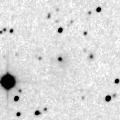
|
Now it is 16.9 mag (May 19, Hidetaka Sato). It will be fading after this. It locates low in the Northern Hempshere.
Date(TT) R.A. (2000) Decl. Delta r Elong. m1 Best Time(A, h)
June 1 19 12.63 -27 40.6 2.062 2.944 144 17.3 2:36 ( 0, 27)
June 8 18 56.63 -25 49.5 2.049 2.996 154 17.3 1:53 ( 0, 29)
|
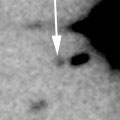
|
Now it is 17.0 mag (Mar. 4, Hidetaka Sato). It keeps 17 mag for a long time from 2012 to 2013, and will be observable in good condition in the Southern Hemisphere. It is not observable at all in the Northern Hemisphere.
Date(TT) R.A. (2000) Decl. Delta r Elong. m1 Best Time(A, h)
June 1 2 16.42 -62 58.4 4.829 4.922 89 17.3 3:03 (327,-35)
June 8 2 17.90 -63 50.3 4.782 4.933 92 17.3 3:00 (328,-32)
|

|
It approached to the Sun down to 0.94 A.U. on May 30. However, because the comet is very tiny, it brightens only up to 17.5 mag. However, A. Diepvens reported it was so bright as 15.3 mag on May 19.
Date(TT) R.A. (2000) Decl. Delta r Elong. m1 Best Time(A, h)
June 1 0 30.26 8 6.7 0.838 0.945 60 17.4 3:03 (273, 19)
June 8 1 6.15 3 25.4 0.858 0.956 60 17.5 3:00 (276, 14)
|

|
Not observed yet in this apparition. It will brighten very rapidly near the perihelion passage. It is expected to reach up to 10 mag from autumn to winter. In the Northern Hemipshere, it keeps observable in excellent condition until the comet fades out. In the Southern Hemisphere, it keeps observable in good condition within 2013, but it will not be observable in 2014.
Date(TT) R.A. (2000) Decl. Delta r Elong. m1 Best Time(A, h)
June 1 22 32.95 -22 23.9 2.202 2.561 98 17.7 3:03 (318, 20)
June 8 22 39.83 -21 44.1 2.071 2.511 103 17.5 3:00 (321, 22)
|

|
First return of a new periodic comet discovered in 1998. It is expected to be observable at 15.5 mag in good condition from 2013 autumn to early 2014. It locates high in the Southern Hemisphere. But it has not been recovered yet.
Date(TT) R.A. (2000) Decl. Delta r Elong. m1 Best Time(A, h)
June 1 0 47.31 -18 42.0 3.425 3.205 69 17.7 3:03 (293, 0)
June 8 0 56.60 -18 26.2 3.314 3.173 73 17.6 3:00 (295, 3)
|

|
Now it is 17.2 mag (May 10, Siding Spring Survey). Now it is brightest, and will be fading after this. It locates low in the Northern Hemisphere.
Date(TT) R.A. (2000) Decl. Delta r Elong. m1 Best Time(A, h)
June 1 12 33.79 -29 17.1 3.399 4.074 125 17.8 20:52 ( 14, 24)
June 8 12 30.46 -26 52.2 3.504 4.087 118 17.8 20:57 ( 23, 24)
|
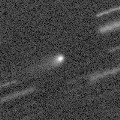
|
Now it is 17.8 mag (May 2, Toshiyuki Takahashi). It brightened up to 16.5 mag in 2012. It will be observable in good condition again at 17.5 mag in 2013 spring.
Date(TT) R.A. (2000) Decl. Delta r Elong. m1 Best Time(A, h)
June 1 12 24.14 10 4.9 5.818 6.246 110 17.8 20:52 ( 36, 61)
June 8 12 20.07 10 1.3 5.959 6.268 103 17.8 20:57 ( 50, 55)
|

|
It has brightened in outburst up to 14 mag twice, in 2006 January and 2011 May. It will pass the perihelion in 2015. It keeps observable at 17 mag for a long time after this.
Date(TT) R.A. (2000) Decl. Delta r Elong. m1 Best Time(A, h)
June 1 19 17.05 -17 32.8 5.830 6.657 141 17.9 2:40 ( 0, 37)
June 8 19 15.24 -17 33.8 5.752 6.642 148 17.8 2:11 ( 0, 37)
|
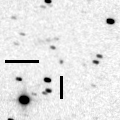
|
Now it is 17.3 mag (Apr. 16, Siding Spring Survey). It keeps 17-18 mag for a long time from 2013 to 2014. It keeps observable in good condition in the Southern Hemisphere. In the Northern Hemisphere, it is only observable until 2012 July.
Date(TT) R.A. (2000) Decl. Delta r Elong. m1 Best Time(A, h)
June 1 14 40.49 -16 54.3 4.286 5.207 152 17.8 21:59 ( 0, 38)
June 8 14 32.86 -17 14.8 4.326 5.183 144 17.8 21:24 ( 0, 38)
|
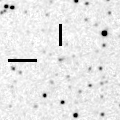
|
Now it is 18.2 mag (Apr. 16, Hidetaka Sato). It keeps 18 mag for a long time from 2013 to 2014.
Date(TT) R.A. (2000) Decl. Delta r Elong. m1 Best Time(A, h)
June 1 15 15.72 -16 6.7 2.620 3.590 160 17.8 22:35 ( 0, 39)
June 8 15 12.69 -15 46.9 2.641 3.574 152 17.8 22:04 ( 0, 39)
|
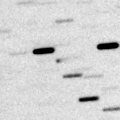
|
Now it is 17.3 mag (May 21, Hidetaka Sato). It will be fading after this, and will be fainter than 18 mag in June.
Date(TT) R.A. (2000) Decl. Delta r Elong. m1 Best Time(A, h)
June 1 22 11.11 -3 29.9 1.400 1.825 96 17.9 3:03 (310, 38)
June 8 22 18.33 -3 7.3 1.366 1.861 101 18.2 3:00 (314, 41)
|
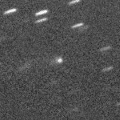
|
It has been observed at 17 mag for a long time from 2009 to 2012. It is also observable at 18 mag in good condition in 2013.
Date(TT) R.A. (2000) Decl. Delta r Elong. m1 Best Time(A, h)
June 1 22 25.13 8 33.5 9.077 9.119 89 17.9 3:03 (295, 44)
June 8 22 23.34 8 38.8 8.978 9.139 95 17.9 3:00 (301, 49)
|
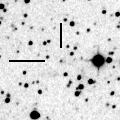
|
It is expected to brighten up to 14 mag from 2015 to 2016. Now it is 18.4 mag (Apr. 8, Hidetaka Sato).
Date(TT) R.A. (2000) Decl. Delta r Elong. m1 Best Time(A, h)
June 1 17 56.17 -2 12.2 7.896 8.805 152 17.9 1:19 ( 0, 53)
June 8 17 54.08 -2 6.9 7.833 8.770 156 17.9 0:50 ( 0, 53)
|
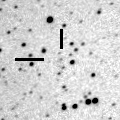
|
It keeps observable at 18 mag for a long time from 2013 to 2014.
Date(TT) R.A. (2000) Decl. Delta r Elong. m1 Best Time(A, h)
June 1 16 43.15 -4 4.8 6.671 7.641 161 18.0 0:07 ( 0, 51)
June 8 16 37.98 -3 30.8 6.673 7.633 159 17.9 23:29 ( 0, 52)
|

|
It brightened up to 2 mag by unusual major outburst in 2007. It was observed around aphelion at 22 mag. It will return in 2014. It will be 14 mag at best by normal prediction. Now it is 17.0 mag, a bit brighter than this ephemeris (May 5, iTelescope Observatory).
Date(TT) R.A. (2000) Decl. Delta r Elong. m1 Best Time(A, h)
June 1 17 45.92 -49 9.5 2.050 2.968 149 18.3 1:10 ( 0, 6)
June 8 17 38.23 -49 14.1 1.999 2.938 152 18.2 0:34 ( 0, 6)
|

|
It was predicted to be 17 mag. But actually, it is much fainter, 19.0 mag (June 3, Hidetaka Sato).
Date(TT) R.A. (2000) Decl. Delta r Elong. m1 Best Time(A, h)
June 1 18 22.93 -16 18.4 1.726 2.675 154 18.5 1:46 ( 0, 39)
June 8 18 18.58 -15 34.5 1.704 2.684 161 18.4 1:14 ( 0, 39)
|
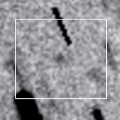
|
It was predicted to be already 15-16 mag. But actually, it is 18.1 mag, much fainter than predicted by 3-4 mag (May 5, Catalina Sky Survey). It was expected to brighten up to 14 mag and to be observable in excellent condition in summer. However, it can be fainter than 18 mag.
Date(TT) R.A. (2000) Decl. Delta r Elong. m1 Best Time(A, h)
June 1 14 58.97 2 37.4 0.861 1.793 145 18.7 22:18 ( 0, 58)
June 8 14 56.66 1 37.9 0.865 1.770 140 18.6 21:48 ( 0, 56)
|
|
![]()
 C/2012 L2 ( LINEAR )
C/2012 L2 ( LINEAR ) 246P/2010 V2 ( NEAT )
246P/2010 V2 ( NEAT ) C/2006 S3 ( LONEOS )
C/2006 S3 ( LONEOS ) C/2010 S1 ( LINEAR )
C/2010 S1 ( LINEAR ) 29P/Schwassmann-Wachmann 1
29P/Schwassmann-Wachmann 1 C/2012 V2 ( LINEAR )
C/2012 V2 ( LINEAR ) C/2013 E2 ( Iwamoto )
C/2013 E2 ( Iwamoto ) C/2011 R1 ( McNaught )
C/2011 R1 ( McNaught ) C/2012 S1 ( ISON )
C/2012 S1 ( ISON ) C/2011 J2 ( LINEAR )
C/2011 J2 ( LINEAR ) 117P/Helin-Roman-Alu 1
117P/Helin-Roman-Alu 1 (596) Scheila
(596) Scheila C/2012 K1 ( PanSTARRS )
C/2012 K1 ( PanSTARRS ) C/2012 K6 ( McNaught )
C/2012 K6 ( McNaught ) C/2009 F4 ( McNaught )
C/2009 F4 ( McNaught ) C/2011 F1 ( LINEAR )
C/2011 F1 ( LINEAR ) 63P/Wild 1
63P/Wild 1 C/2009 P1 ( Garradd )
C/2009 P1 ( Garradd ) C/2013 G6 ( Lemmon )
C/2013 G6 ( Lemmon ) C/2012 S3 ( PanSTARRS )
C/2012 S3 ( PanSTARRS ) C/2013 F3 ( McNaught )
C/2013 F3 ( McNaught ) 152P/Helin-Lawrence
152P/Helin-Lawrence P/2012 B1 ( PanSTARRS )
P/2012 B1 ( PanSTARRS ) P/2012 F2 ( PanSTARRS )
P/2012 F2 ( PanSTARRS ) C/2011 O1 ( LINEAR )
C/2011 O1 ( LINEAR ) C/2012 V1 ( PanSTARRS )
C/2012 V1 ( PanSTARRS ) 257P/2012 F4 ( Catalina )
257P/2012 F4 ( Catalina ) C/2013 G5 ( Catalina )
C/2013 G5 ( Catalina ) 184P/Lovas 2
184P/Lovas 2 P/2005 L1 ( McNaught )
P/2005 L1 ( McNaught ) C/2013 J2 ( McNaught )
C/2013 J2 ( McNaught ) C/2013 G2 ( McNaught )
C/2013 G2 ( McNaught ) C/2012 C1 ( McNaught )
C/2012 C1 ( McNaught ) C/2013 K1 ( Christensen )
C/2013 K1 ( Christensen ) 154P/Brewington
154P/Brewington P/1998 Y2 ( Li )
P/1998 Y2 ( Li ) C/2013 J3 ( McNaught )
C/2013 J3 ( McNaught ) C/2010 R1 ( LINEAR )
C/2010 R1 ( LINEAR ) 174P/(60558) 2000 EC98 ( Echeclus )
174P/(60558) 2000 EC98 ( Echeclus ) C/2013 G7 ( McNaught )
C/2013 G7 ( McNaught ) P/2013 G1 ( Kowalski )
P/2013 G1 ( Kowalski ) 125P/Spacewatch
125P/Spacewatch C/2008 S3 ( Boattini )
C/2008 S3 ( Boattini ) C/2011 KP36 ( Spacewatch )
C/2011 KP36 ( Spacewatch ) C/2013 H2 ( Boattini )
C/2013 H2 ( Boattini ) 17P/Holmes
17P/Holmes 91P/Russell 3
91P/Russell 3 98P/Takamizawa
98P/Takamizawa![]()








































